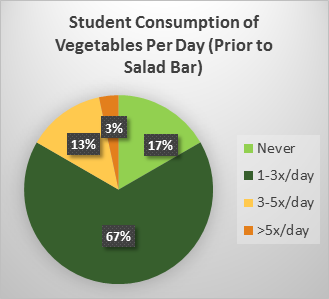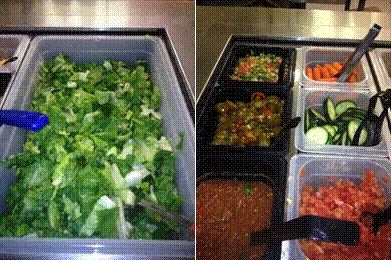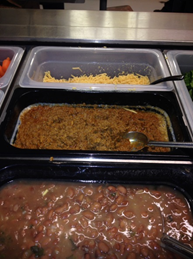Share On Social!
Alexander Castillo was looking to make some healthy changes in his own life when he came to the realization that his school lacked tasty, nutritious lunch options. Why couldn’t his school have a salad bar? After joining the Mayor’s Fitness Council Student Ambassador program, developing a plan with his mentor, and reaching out to his district’s food services department, Alexander was able to secure a salad bar for his high school. The new salad bar led to an increase in salad purchases and a new outlook on eating fresh fruit and vegetables at his school.
EMERGENCE
Awareness: Alexander Castillo, a student at Southwest Academy (a non-traditional alternative high school in the mostly Latino city of San Antonio, Texas) set a goal to pursue his passion for wrestling in 2014.
He started trying to make healthier choices, eating better and working out.

At six-foot-five-inches tall and having previously weighed over 300 pounds, Alexander was starting to lose weight and gain muscle.
But he noticed his school lacked healthy, fresh menu options.
Mary Beth Fries, a teacher at Southwest Academy and Alexander’s mentor, said school lunches were not exactly “pleasant.”
“So what kids would often do is bring their own snacks and put them in the middle of the table,” she said.
Learn: Alexander wanted to have healthier lunch options at school to help meet his own goals and enable his peers to eat better.
Why not a salad bar?
“Alexander came to me and said, ‘We need a choice in our cafeteria,’” Fries said.
Around that time, Fries suggested Alexander apply for the San Antonio Mayor’s Fitness Council Student Ambassador program, which helps local students make healthy changes in their communities, but had never had a student participant from Southwest Independent School District (Southwest ISD).
Alexander and several others applied in Spring 2014.
Frame Issue: At first, Fries wasn’t sure that Alexander’s idea for a school salad bar was feasible.
But when Alexander (and his classmates Tiffany, James, and David) were approved as part of the student ambassador program, Fries believed they could get support for such a change. At an initial meeting of the ambassadors program, students reflected on what their school and community needed the most, and helped them envision how their ideas could make a long-term impact.
Alexander and his classmates outlined the improvements they wanted to see at their school.
No. 1? Healthier food with a salad bar.
DEVELOPMENT
Education: To start, Alexander spoke to local members of the community at a student ambassador meeting.

One meeting attendee, Jeremy Beer, special projects manager for the Mayor’s Fitness Council, offered to see what could be done to help Alexander’s school get a salad bar.
Beer learned that the school district already had some salad bars, they just weren’t in use.
The students didn’t have to worry about purchasing a salad bar, they just had to figure out how to bring it into their high school.
Mobilization: Fries, on behalf of her students, emailed the district’s dietician Debbie Rice.
Rice mentioned several challenges associated with operating a free-standing salad bar.
Nonetheless, Rice agreed to meet with Alexander and his classmates to discuss the idea of installing a salad bar at Southwest Academy.
Debate: In October 2014, Rice visited Alexander and his classmates.
“She pulled us aside at lunch and we talked about it.” Alexander said. “We told her that we wanted to make a change for the students and the teachers.”
Rice explained that, because the school only had 200 students and cafeteria staff was limited, installing a free-standing salad bar at Southwest Academy was not feasible due to staffing and demand issues.
The school didn’t have an extra worker to maintain a free-standing salad bar (in addition to its one food services manager and two cafeteria workers), Rice said.
Rice also explained that the district had previously tried salad bars and that only a handful of students purchased salads from them.
Given these constraints, Rice provided a second alternative to students.
A salad bar could be part of the lunch, instead of free-standing, Rice said.
“I told them we’ll make a space on the line and give you everything you’re looking for, but you have to cheer-lead for it,” Rice said.
ENACTMENT

Activation: After gaining a better understanding of the challenges associated with food service operations at his school, Alexander and his fellow ambassadors at the Academy agreed to champion the new lunch alternative, which would be installed for a trial run at the school’s cafeteria.
To alert the student body of the soon coming lunch-line salad bar, Alexander asked students and teachers for their support during morning announcements. He explained that the salad bar would contain fresh romaine lettuce, cucumbers, carrots, tomatoes, as well as a “spice bar” to give salads extra flavor without added sodium.
Rice and her team kept their end of the bargain by purchasing the new equipment the school would need (such as precise nutrient-measurement spoons) to operate the salad bar and by posting flyers at the lunch line to announce the new lunch option.
To gain a better understanding of food purchasing patterns, prior to installing the salad bar, Rice distributed a four-question survey to students. The survey asked:
1) How many times a day students consumed fruits and vegetables;
2) How often they purchased boxed salads from the cafeteria;
3) How satisfied students were with current salad options; and
4) Whether students would eat more salads during the week if a salad bar was installed.
Initially, only 3% of students surveyed said they ate vegetables more than 5 times a day, while 17% said they never ate vegetables. There was also a high number of students who didn’t eat salads (23%) and who reported being strongly dissatisfied (44%) with their current salad options.
Frame Policy: Before agreeing to install the salad bar, Rice had made clear to Alexander what the expectations would be.

Each student would be required to take:
• Two Scoops of Lettuce;
• Two 1-ounce scoops of protein (i.e. ham, turkey, fajita chicken, beans, or cheese);
• Two Grains; and
• Endless toppings (cucumbers, carrots, tomatoes, red peppers, cranberries, seeds, etc.)
If students did not buy enough salads, the school might have to shut down the salad bar. As long as the school could at least break even with their salad sales, then the salad bar would remain open.
Change: On Tuesday, Jan. 20, 2015, the new salad bar opened at Southwest Academy.
Both students and teachers were excited to have this healthy option.
For teachers, the salad bar only costs $3.40. The cost to students is even lower.
“Most of the students are really intrigued with the salad bar, they’ll try the spice rack and they enjoy it,” said Alexander. “A lot of students come up to me and thank me because they’re getting the proper nutrition and it tastes good.”
IMPLEMENTATION
Implementation: Since the school installed a new salad bar, Alexander says he feels energized and happy to know that he was able to be a part of bringing this healthy change to his school.

“I’ve always wanted to be somebody that others can look up to, someone that can be an inspiration,” Alexander said. “It’s an honor…all I can do is thank them [the students, faculty, and staff at Southwest] for the support.”
Equity/Sustainability: Two weeks into the project, Rice looked at the sales records for salads purchased and found that sales had increased.
The cafeteria sold an average of four salads a day before, and increased to 30 a day after the lunch-line salad bar. The percentage of those who consumed vegetables 5 times or more per day increased to 27% and the percentage of those who reported never eating vegetables decreased to 0%.
“It was a compromise and a win-win situation,” said Rice. “At the end of the day, students are eating more fruits and vegetables…that’s a huge accomplishment.”
Now that the students at Southwest Academy have their salad bar in place Alexander hopes to expand physical activity opportunities by starting a bi-weekly or monthly fitness event at his school.
Fries says they may even open up this fitness opportunity to the community.
This success story was produced by Salud America! with support from the Robert Wood Johnson Foundation. The stories are intended for educational and informative purposes. References to specific policymakers, individuals, schools, policies, or companies have been included solely to advance these purposes and do not constitute an endorsement, sponsorship, or recommendation. Stories are based on and told by real community members and are the opinions and views of the individuals whose stories are told. Organization and activities described were not supported by Salud America! or the Robert Wood Johnson Foundation and do not necessarily represent the views of Salud America! or the Robert Wood Johnson Foundation.
ABOUT THE PROGRAM
Salud America! The RWJF Research Network to Prevent Obesity Among Latino Children is a national program of the Robert Wood Johnson Foundation. The program aims to educate researchers, decision-makers, community leaders, and the public in contributing toward healthier Latino communities and seeking environmental and policy solutions to the epidemic of Latino childhood obesity. The network is directed by the Institute for Health Promotion Research at the University of Texas Health Science Center at San Antonio.
For more information, visit http://www.salud-america.org.
By The Numbers
142
Percent
Expected rise in Latino cancer cases in coming years
This success story was produced by Salud America! with support from the Robert Wood Johnson Foundation.
The stories are intended for educational and informative purposes. References to specific policymakers, individuals, schools, policies, or companies have been included solely to advance these purposes and do not constitute an endorsement, sponsorship, or recommendation. Stories are based on and told by real community members and are the opinions and views of the individuals whose stories are told. Organization and activities described were not supported by Salud America! or the Robert Wood Johnson Foundation and do not necessarily represent the views of Salud America! or the Robert Wood Johnson Foundation.



